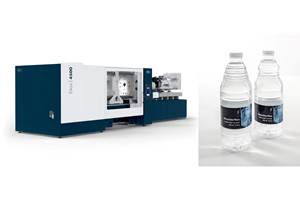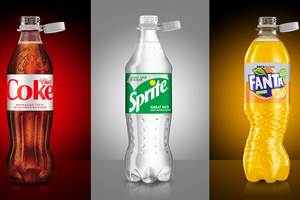All-Electric Blow Molding Still in Its Infancy in U.S.
Already a familiar sight on European store shelves, the eye-catching appeal of "IML" is gaining traction among North American injection molders. The latest tooling and automation designs can handle the higher volumes needed here.
Custom blow molder Dahl-Tech Inc. of Stillwater, Minn., was an early adopter of all-electric blow molding machines, which have been commercially available since the 1990s. Yet so far, these machines remain the rare exception in North America. Suppliers such as Bekum, Kautex, Meccanoplastica, Magic, Techne, Sipa, and W. Amsler report few or no sales of their machines in the U.S., although some have seen success in other markets. The attraction of all-electrics is said to be energy savings, speed, precision, repeatability, quietness, and oil-free cleanliness. However, some suppliers say that the price premium for the machines—about 10% to 20% above a comparable hydraulic machine—as well as weak overall market demand for machinery during the recession, have slowed adoption of all-electrics. However, they add that emerging markets such as clean-room medical applications and larger parts capability may spur growth. One example of the turnaround is Dahl-Tech.
The company, a mid-sized molder established in 1979 as a custom job shop for PE blow molded containers, signature stock bottles and jugs, and PET stretch-blown containers, operates 13 blow molding lines from its single facility, including an all-electric reheat PET stretch-blow machine installed last spring from W. Amsler Equipment Inc., Richmond Hill, Ont. (amslerequipment.net).
SOLVING A PROBLEM
Fifteen years ago, Dahl-Tech purchased two machines for PET, one hydraulic and one all-electric, from overseas machine makers. The goal was to expand its business outside of HDPE bottles and to try to secure a large customer that was looking for high-volume parts at a low piece price, says Bob Dahlke, president. “The hydraulic machine required constant downtime for repair and maintenance, yielded plenty of scrap parts, did not have what we considered the most up-to-date controls for handling the preform, and the machine design made mold changes cumbersome. This resulted in too high a piece price. PET is more expensive than HDPE, which makes the waste that much more significant.”
The all-electric PET unit purchased at the time had its own issues, says Dahlke. “The machine we ordered was delayed at the border for a month, and then when it was delivered into the plant the technicians (theirs and ours) could not make the machine run,” he says. The two missteps cost Dahlke PET business with the large customer. But Dahlke remained interested in the PET market, as there were no other molders in the area to serve that need.
Dahl-Tech’s purchase of the W. Amsler machine yielded a crop of benefits. “One main reason for getting the machine is that it comes from North America, so any need for replacement parts can be handled quickly,” says Dahlke.
Molding repeatability and precision are a big plus with the new unit. “With the other machines, we were throwing away gaylords of material due to poor process repeatability, but with the Amsler unit we have thrown out barely more than one gaylord so far this year,” says Dahlke. Mold changes now are easier and faster. “We can complete a mold change in about 15 min now, compared with 1.5 to 2 hr on other machines.”
The all-electric’s ability to overlap process steps has helped Dahlke run faster. The combination of speed, repeatability, and reduced downtime helped the company enter into the market for PET honey jars. “We were able to shave one full second off cycle times, and that gave us the ability to compete in this market,” says Dahlke. The firm molds PET bottles from 8 to 32 oz in six to 12 cavities.
NEW MACHINES FOR NEW MARKETS
Suppliers of all-electric extrusion and injection-blow machines report a small number of users of their units so far in the U.S. Few, if any, of these molders appeared willing to talk about their experience with all-electric technology, perhaps because they think it gives them an edge and they prefer not to spread the word of its advantages.
Kautex Machines Inc., North Branch, N.J. (kautex-group.com), has two of its all-electric extrusion blow machines in operation at custom molder Parker Plastics, based in Pleasant Prairie, Wis.
Meccanoplastica of Italy, represented here by Meccanoplastica USA, New Hope, N.J. (meccanoplastica.com), sold two of its new-model JET 55 all-electric injection-blow machines (55 tons) to custom molder Comar Inc. in Buena, N.J.
Bekum America Corp., Williamston, Mich. (bekumamerica.com), has sold two of its eBlow all-electric extrusion blow machines to a customer in Europe, but none so far in the U.S.
Suppliers say that all-electrics, and perhaps also electric/hydraulic hybrid models, are starting to attract attention from the pharmaceutical industry, where the machines are suited to clean-room applications. This and a trend to bigger machine sizes are spurring introduction of new electric models.
W. Amsler just introduced its L120 series machine for 5-gal PET water containers, marking the company’s entry into machines for larger containers. Until now, its units have been capable of 50 ml to 5 liters. Amsler builds only all-electric models.
Meccanoplastica will introduce an electric shuttle machine at the K 2010 show in Dusseldorf this fall, and a larger (99-ton) electric injection-blow unit at NPE 2012.
Magic SpA of Italy, represented here by Blow Mold Solutions Co., Elwood, N.J. (blowmoldsolutions.com, magicmp.it), has a substantial number of all-electric and hybrid models installed worldwide, but only hybrids have been sold yet in the U.S. Magic stopped producing fully hydraulic machines at least five years ago to focus its efforts on all-electrics and hybrids. It offers the fully loaded, all-electric EP line; a re-engineered, less expensive all-electric ME line; and its hybrid IB line.
Magic recently rolled out its UE (Ultra Economical) line, which includes all-electric models priced 15% below the ME line and a hybrid priced 20% below the IB line. At K 2010, Magic will show a 30-liter ME model, its largest all-electric machine to date.
Some electric models made their debut at last year’s NPE 2009 show in Chicago. Sipa North America, Atlanta (sipa.it), launched its SFL2 line of all-electric linear reheat PET stretch-blow models. Techne North America, Fort Worth, Texas (technespa.com), introduced its Advance ADV4/510 all-electric extrusion blow shuttle and plans to bring out a larger unit with 700-mm stroke and using nearly 50% less energy than hydraulics, up from 30% savings with the current model. Apart from such savings, Techne says speedy all-electrics beat hydraulics in capital cost per unit of throughput capacity—one reason why about 80% of its quotes and sales nowadays are for all-electrics, which it has supplied to China, Brazil, and Europe.
Related Content
Breaking News From NPE2024
Here is a firsthand report of news in injection molding, extrusion, blow molding and recycling not previously covered.
Read MoreKrones Acquires Netstal
Krones adds PET preform injection molding to its bottle blowing and filling capabilities, as well as cap molding and expansion into medical, food and other markets.
Read MoreEnd-to-End Quality Management For Aseptic PET Beverage Bottling
Sidel introduces Qual-IS comprehensive quality system to merge all QC activities in PET aseptic beverage bottling, from the preform blowing to laboratory management.
Read MoreCoca-Cola Europacific Transitions to Tethered Caps and Lighter PET Bottle
Sidel is converting all Coca-Cola PET bottling lines in Europe to meet new EU packaging regulations by July 2024.
Read MoreRead Next
People 4.0 – How to Get Buy-In from Your Staff for Industry 4.0 Systems
Implementing a production monitoring system as the foundation of a ‘smart factory’ is about integrating people with new technology as much as it is about integrating machines and computers. Here are tips from a company that has gone through the process.
Read MoreSee Recyclers Close the Loop on Trade Show Production Scrap at NPE2024
A collaboration between show organizer PLASTICS, recycler CPR and size reduction experts WEIMA and Conair recovered and recycled all production scrap at NPE2024.
Read More












